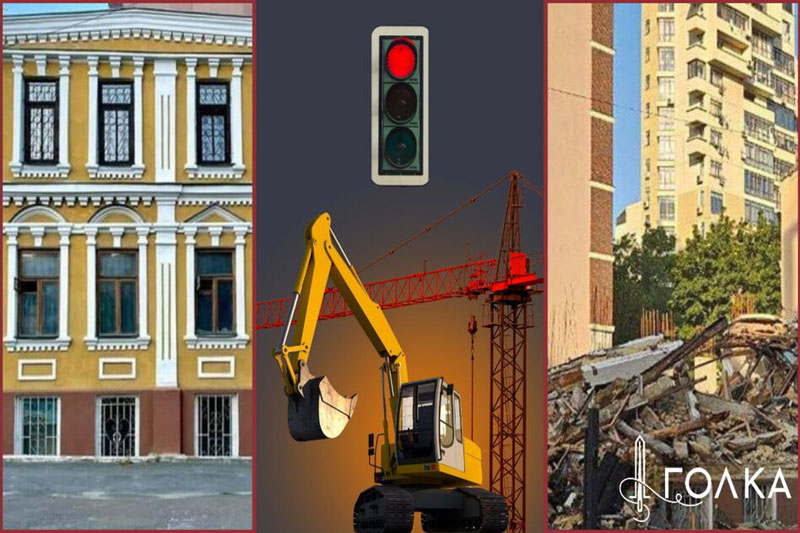Снос усадьбы Зеленских. Минкульт Карандеева вернул правила времен Януковича?


Приказ Минкульта лишил граждан права защищать культурное наследие
В столице на выходных вспыхнул скандал. Снесли усадьбу Зеленских. Мэр Киева Виталий Кличко уже успел назвать произошедшее «циничной провокацией» и отметил, что профильный департамент КГГА за несколько дней до того отправил в Минкульт документы, чтобы защитить здание и предоставить статус памятника: «Активисты приходят под здание мэрии.
Мол, «Кличко снес памятник». Но почему возмущенные демонстранты не идут и не задают вопросов парламенту, который уже более 5 лет так и не принял поданный городом законопроект, чтобы столица имела рычаги влияния на недобросовестных владельцев старинных зданий? Почему не обращаются к правительству, от которого город уже столько лет требует вернуть в собственность общины дом Сикорского, который находится на балансе Минобороны. Тот же Кабмин заблокировал передачу общине Гостиного двора, который город вместе с активистами вернул из частной собственности в государственную. А памятник тоже стоит без реконструкции и разрушается».
Ответ от и.о. министра культуры Ростислава Карандеева не заставил себя ждать. Он назвал это ложными упреками, обвинил во всем столичную власть, которая ненадлежащим образом работает на этом направлении.
На самом деле снос усадьбы Зеленских — это повод посмотреть на проблему защиты культурного наследия шире.
Враг пытается уничтожить историю Украины и культурное наследие. Поэтому защита памятников — один из столпов защиты национальной безопасности и сохранения национальной идентичности. Когда застройщик, у которого нашли российский шлейф, уничтожал в центре Киева здание «Цветы Украины», то киевляне смогли защитить его. Они добились того, чтобы зданию оперативно дали статус памятника. Тогда помог Минкульт, действовали другие правила.
Ключевую роль в процессе защиты памятников всегда играла общественность. Так вот этой весной появился приказ, который лишил права граждан защищать культурное наследие. И Минкульту такую политику позволил принять Минюст и Государственная регуляторная служба.
Последняя, напомним, прикрывала постановление-клон градостроительной «реформы» 5655. А это тоже было нужно застройщикам, которым, кстати, культурное наследие часто мешает делать свои бизнес-проекты и поэтому прокуратура годами в судах защищает Пирогов, Китаев, Музей выдающихся деятелей Украины, Литературный сквер. (В этих делах есть серьезные вопросы и к депутатам Киевсовета, и к тому, какую позицию власти города занимают в судах).
Новые процедуры несут коррупционные риски. Здесь чиновники проигнорировали Государственную антикоррупционную программу и требования о проведении публичных консультаций при создании таких документов. На это должно реагировать НАПК.
Общественная инициатива «Игла» изучила новые правительственные политики в отношении культурного наследия и выяснила, что власть вернула правила игры, которые утверждали во времена Януковича.
Статус памятника и роль граждан
Когда здание внесено в Государственный реестр недвижимых памятников Украины, то если кто-то его будет разрушать — это криминал. Более того, владелец должен такое здание беречь. Это предусмотрено законом «Об охране культурного наследия».
Как только застройщик узнает о том, что зданию могут предоставить статус памятника — его могут быстро снести. Тогда нечего будет вносить в Реестр и вместо исторического здания будет какая-то коммерчески выгодная недвижимость. Именно это и произошло с «Цветами Украины» в центре Киева. Незадолго до того, как здание попало в Реестр — фасад успели уничтожить.
Для того, чтобы подобное не происходило, есть специальный статус «только что выявленный объект культурного наследия». Он позволяет зданию «дожить» до того времени, как пройдут необходимые процедуры и здание внесут в Госреестр памятников. В этот промежуточный период сооружение попадает в специальный перечень. И за его разрушение тогда тоже предусмотрена уголовная ответственность.
Процедура в таких случаях действительно должна быть максимально простой и быстрой. Но далеко не каждое историческое здание имеет значительную культурную ценность, чтобы получить статус памятника. Поэтому есть риски злоупотреблений банального вымогательства с владельцев рядовых исторических зданий.
Поэтому надо установить жесткие сроки к органам охраны культурного наследия, которые готовят документы для рассмотрения вопроса внесения объекта в Реестр.
Минкульт, когда 11 лет назад решил изменить советские правила, утвердил новый Порядок, который не предусматривал участия общественности в таких процессах. При этом общественность имела возможность… добиться прямо противоположного — снять со здания охранный статус. Можем предположить, что эту лазейку оставили в интересах застройщиков, которые могли найти «правильную общественность», инициирующую снятие статуса памятника с нужного объекта.
Настоящая революция произошла после президентских выборов 2019 года, когда Минкульт еще при премьере Владимире Гройсмане, утвердил новую редакцию Порядка. И вот тут наконец-то появилась общественность, когда речь идет о внесении объекта в Перечень и предоставлении статуса только что выявленного объекта культурного наследия. Список документов, которые для этого надо было подать, уменьшили до минимума. Стоило иметь только фотофиксацию объекта и историческую справку, которую должен был подписать человек с ученой степенью по соответствующей специальности (искусствоведение, архитектура, история и т.д.).
Отказать можно было только при отсутствии документов или отсутствии в исторической справке обоснований аутентичности объекта или его ценности.
Но здесь был очень существенный недостаток. Сроки рассмотрения обращения граждан не установили. А затягивание с рассмотрением документов — это шанс владельцу уничтожить или реконструировать объект так, как он того и хотел.
Но даже при таких условиях выход был. Общественность могла подавать документы в Минкультуры на присвоение статуса памятника местного значения без рассмотрения вопроса на уровне государственных администраций.
Это требовало дополнительного изготовления учетной карточки и акта состояния сохранности объекта. Но сделать это — вполне реально. Например, именно таким образом было остановлено разрушение модернистского здания павильона «Цветы Украины» в Киеве.
Бывший министр культуры Александр Ткаченко ушел в отставку год назад. С тех пор министерство возглавляет исполняющий обязанности Ростислав Карандеев. Весной Минкульт сменил Порядок.
Как Минкульт заблокировал участие граждан?
Отныне профильные общественные организации не могут по собственной инициативе готовить документацию для внесения объекта в Перечень. Они должны обратиться в соответствующий орган охраны культурного наследия, подав Карточку выявления объекта культурного наследия.
Здесь уже появились сроки для рассмотрения — 10 рабочих дней есть, чтобы орган принял решение об отнесении или неотнесении объекта к недвижимым объектам культурного наследия и необходимости составления на него учетной карточки. Но как именно это решение должно приниматься и какие основания «неотнесения» — новым Порядком не урегулировано.
Уже на этом этапе чиновники в интересах владельца потенциально ценного объекта могут полностью заблокировать инициативу общественности — без зарегистрированной Карточки невозможно осуществить дальнейшие процедурные шаги.
И главное, за то, что объект не попал вовремя в Перечень, индивидуальной ответственности больше нет. Опять все скрывается за коллективной безответственностью. Чиновник должен был бы просто проверить правильность подготовки документов, как это было с 2019 года, а теперь эти документы должен рассматривать Консультационный совет при органе охраны культурного наследия. По сути, если смотреть на процедуру, то мы вернулись к редакции, утвержденной во времена Януковича.
И такой совет должен проверить наличие у объекта ценности и соответствие его критериям для памятников. И если совет принимает коллегиально решение, что объект не соответствует требованиям к памятникам, то орган охраны культурного наследия отказывает во внесении здания в Перечень.
Такие советы действуют на основании типового положения, утвержденного Минкультом в эпоху Леонида Кучмы. Поэтому никакого влияния общественности на формирование Консультативного совета не предусмотрено — его состав по собственному усмотрению утверждает руководитель органа охраны культурного наследия, который одновременно и является председателем этого совета. Никакой прозрачности и открытости его работы также не предусмотрено.
То есть, имеем коллегиальный орган, который за закрытыми дверями может принять любое решение путем голосования, тем самым сняв ответственность с чиновников за их последующие действия. Риск значительно усиливают утвержденные Кабмином критерии к памятникам, представляющие собой набор субъективных понятий и неконкретных требований.
Например, объект должен «в значительной степени сохранить свою форму и материально-техническую структуру, исторические культурные наслоения». «В значительной степени», это на сколько? Для кого-то хватит и 10%, а для кого-то нужно 90%. Чем «значительное влияние» на развитие культуры отличается от просто «влияния»? Как убедиться, что определенные люди или события сделали именно «значительный вклад» в развитие культуры, а не просто «вклад»?
Все это позволяет легко манипулировать ценностью объекта и не нести за это ответственности. Единственное, что может здесь спасти — это отбор в экспертные и консультативные органы известных независимых специалистов и полная открытость в их работе.
Подход с обязательной проверкой соответствия объекта критериям для памятников на стадии внесения в Перечень является уместным в наших реалиях, потому что это может стать мощным предохранителем от построения коррупционных схем для вымогательства с владельцев зданий.
Но проверка должна быть построена без указанных выше коррупционных рисков. Предложенный Минкультом вариант точно не минимизирует этих рисков и вместе с этим позволит уничтожать культурное наследие.
Если на уровне государственных администраций кто-то будет блокировать внесение сооружения в Перечень, то в Минкульт уже обращаться нельзя, как это было раньше.
Остались лишь отдельные отголоски старых возможностей, вроде права Минкульта направить учетную документацию с соответствующим протоколом Экспертной комиссии в уполномоченный орган для принятия решения о занесении объекта культурного наследия в Перечень.
При этом рассматриваются исключительно вопросы о внесении в Реестр только что выявленных объектов культурного наследия и объектов, получивших статус памятника по старому законодательству. Поэтому регулирование возвращается к тому состоянию, каким было во времена Януковича.
Как протягивали тайком новые изменения?
Общественность не знала о намерениях Министерства. Все происходило под видом выполнения Государственной антикоррупционной программы (мероприятие 2.5.2.1.4), которая предусматривала лишь внесение изменений в существующий Порядок. И не любых изменений, а вполне конкретных: мониторинга и контроля в случае задержек более трех лет с рассмотрением вопросов о внесении в Реестр объектов из Перечня, и приведения Порядка в соответствие с законами о запрете пропаганды тоталитарных режимов и российской имперской политики.
При этом, согласно Государственной антикоррупционной программе, проект такого приказа Минкульта должен был пройти общественные обсуждения (мероприятие 2.5.2.1.5). Министерство даже это предусмотрело в Ориентировочном плане консультаций на 2023 год, а затем и в плане на этот год, когда подготовка проекта приказа затянулась (пункты 5 и 3 соответственно).
НАПК пока на запрос «Голки» не предоставило ответ. Как только он поступит — он будет обнародован.
Следует добавить, что Порядок является регуляторным актом. В 2019 году, когда действующий и.о. министра культуры Карандеев был госсекретарем в Минкультуры, проект предыдущей редакции Порядка проходил все процедуры, как регуляторный акт, подавался на согласование в Государственную регуляторную службу, и был ею согласован.
Но обязательные консультации с общественностью Минкульт перед изданием приказа на этот раз не проводил.
Такие нарушения Минкульт объяснил НАПК наличием письма Государственной регуляторной службы, что «проект акта не содержит норм регуляторного характера, а его принятие не требует проведения процедур, предусмотренных законом Украины „Об основах государственной регуляторной политики…“.
Получается интересная ситуация. В 2019 году Государственная регуляторная служба под руководством Ксении Ляпиной установила, что Порядок является регуляторным актом. А сейчас почему-то ситуация изменилась.
Здесь стоит напомнить, что Государственная регуляторная служба так поступает не впервые. Общественная инициатива «Игла» писала, что для того, чтобы в интересах застройщиков провести правительственный «эксперимент» и протянуть постановление-клон скандальной градостроительной реформы 5655, тоже аналогичным образом обошли общественность.
В своем ответе на запрос общественной инициативы Государственная регуляторная служба отметила, что проанализировала документ Минкульта повторно, но и дальше отрицает, что документ содержит изменения, которые регулируют хозяйственные отношения и отношения между органами власти и субъектами хозяйствования.
При этом, раздел III нового Порядка устанавливает требования к субъектам хозяйствования, имеющим право разрабатывать учетную документацию на памятники (п. 3.3), требования к оформлению субъектами хозяйствования соответствующей документации (п. 3.2, 3.4-3.6) и порядок ее передачи Заказчику (п. 3.7).
Но приказ Минкульта никогда бы не вступил в действие со всеми описанными выше коррупциогенными нормами и нарушениями процедуры консультаций с общественностью, если бы его не согласовал Минюст под руководством Дениса Малюськи. Минюст ознакомился с документом и обнаружил более 100 (!) различных ошибок в формулировках, которые исправлялись отдельным приказом. Но замечания были только к форме, а не к содержанию или процедуре подготовки.
Этот случай в работе Минюста интересен тем, что есть возможность сравнить принципы работы Минюста сейчас и летом 2019 года, когда согласовывали предыдущую редакцию Порядка. 5 лет назад Минюст вернул все Минкультуры и обязал пройти процедуру консультаций с общественностью, как для регуляторного акта. И проект приказа вынужденно подали в Государственной регуляторной службе на согласование уже после издания самого приказа. Благодаря этому были учтены предложения, которые прислали Реанимационный Пакет Реформ и ОО «Вместе против коррупции».
Поэтому, если говорить о том, как государственные институты работают по тем же законам во время войны, — выводы неутешительны. Есть систематические попытки протягивать через правительство нормативные акты с нарушением законодательства и с сознательным сокрытием их проектов от общественности. Ключевые государственные органы, которые должны обеспечивать контроль за соблюдением законодательства при нормотворчестве, действуют прямо противоположно и обеспечивают крышу нормативным махинациям ряда министерств.
Начальник управления согласительно-разрешительной документации Минкульта Наталья Войцещук в комментарии отмечает: «Новые изменения в порядок учета наоборот сделали процедуру более последовательной, публичной и более открытой для привлечения специалистов в сфере охраны культурного наследия. Да, возможно, что не все возможные случаи и ситуации были при этом учтены. Поэтому мы внимательно рассмотрим и промоделируем высказанные замечания и риски аналитиков. Также замечания и предложения появятся (и они уже есть) от органов охраны и разработчиков учетной документации, инициаторов представления объектов в процессе практической реализации этой версии Порядка учета, особенно в связи с тестированием Информационно-коммуникационной системы учета недвижимых объектов культурного наследия Украины «Государственный реестр недвижимых памятников Украины».
Recent Posts
Сбежавший в Швейцарию блогер Станислав Домбровский просит прощения у украинцев
Одесский трэш блогер Стас Домбровский, который в последнее время проживает в Швейцарии, записал видеообращение к…
Александра Устинова и атака на руководство АОЗ: что стоит за волной критики
Александра Устинова, народная депутат, которая в последние дни активно атакует Агентство оборонных закупок (АОЗ) возможно…
Журналисты показали имение киевской судьи, закрывшей дело Приходько
Свобода "под ключ" или манипуляция правосудием? Борис Приходько – нацбанкир времен Януковича и действующий нардеп…
Судьи вне закона
В течение последних трех лет внимание общественности если и бывает приковано к судам, то гораздо…
Артем Ляшанов и bill_line спасают репутацию через суд
Финтех-компания столкнулась с обвинениями в отмывании денег игорной мафии. ООО «Тех-Софт Атлас» (ТМ «bill_line») и…
Криптобиржа WhiteBIT: как Владимир Носов и «регионалы» Шенцевы отмывают деньги и помогают спецслужбам России
Владимир Носов в Украине пытается позиционировать себя как респектабельный бизнесмен и хозяин криптобиржи WhiteBIT. Однако…



